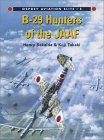|
|
|
|
| Missing In Action (MIA) | Prisoners Of War (POW) | Unexploded Ordnance (UXO) |
| Chronology | Locations | Aircraft | Ships | Submit Info | How You Can Help | Donate |
|
 by Koji Takaki & Henry Sakaida Publisher 2000 Soft cover 128 pages Index, photos, artwork ISBN: $25.95 Language: English Order now at amazon.com Return to |
Osprey Aviation Elite 5 B-29 Hunters of the JAAF Little is written about the Japanese air defense of the the home islands at the end of WWII. This story is told in with vivid pilot profiles, mission histories and stunning photographs. History and accounts from both the Japanese and American sides of the campaign allow the reader to understand the vicious aerial combat that occurred in the skys over Japan, from late 1944 until the end of the war. Like so many other defensive battles of the Pacific, the defense of the home islands was fanatical. Although marred by operational problems, and stiff resistance, B-29 raids succeeded in bringing the war home to Japan, and the county to its knees. This is the story of the pilots who defended Japan, and the stories of the B-29s they destroyed. Three Phases of American Strategic Bombing The American strategic bombing campaign was carried out by the 20th and 21st Air Forces. Divided into three phases, and carried out by the Boeing B-29 Superfortress. The first phase, commanded by Brig. General Harold Hansell was the strategic bombing of Japanese military targets, a phase that was plagued with problems of stiff enemy resistance, flak, and the weather - in the form of intense jet stream air currents that reduced effectiveness. The second phase, commanded by Curtis LeMay, began with the same tactics, but lower altitude, and incendiary bombing tactics were introduced in an effort to destroy miles of urban homes and smaller factories. The final phase was a targeting of airfields, so as to reduce the volume of Kamikaze attacks on the American forces off Okinawa. Japanese Defenders Little has been previously published in English about the Japanese pilots who defended Japan. This book tells their story, about determined defense. Contrary to popular belief, the Japanese home island defense was a well organized effort, including early warning networks of radar and relay stations, and searchlight, anti-aircraft batteries and fighter defenses. Unlike other campaigns, the Japanese adopted ramming as a standard tactic, as my of their aircraft were woefully under armed to destroy the massive B-29 otherwise. After reading the accounts of the Japanese pilots, their courage and determination can not be denied. Many preformed daring attacks at all odds, and some preformed, and survived several ramming attacks. Ramming pilots were hailed as heroes by the government and newspapers, and as the war continued, more aircraft were designated for ramming, further validating the tactic. As is often the case in air war, their claims by both sides were often inflated or exaggerated. But, the impact of Japanese fighters on the attacking B-29 formations, and losses they inflicted were undeniable. The brunt of the the aerial defense was preformed by Japanese Army Air Force fighters, including the Ki-44 Tojo, the twin engine Ki-45 Dinah, Ki-61 Tony, and Ki-84, among others. Like their American counterparts, the Japanese aircraft also had operations and performance issues with their planes in high altitude interceptions. Often, aircraft would strip out all unnecessary equipment for extra altitude performance. The book is unique in its detailed documentation of both the Japanese and American sides of many of the B-29 fighter losses, where crews managed to survive. This is a real credit to the collaborative efforts of the book's authors. Each aircraft is illustrated with many WWII photos, of the aircraft, its crews, and in many cases their crash site, and haunting photographs of the 'death' of stricken B-29s from the air and from the ground. B-29 Hunters of the JAAF explore the plight of B-29 POW's of the Japanese, and their brutal treatment by the Kempi-Tai, execution in military trials for bombing civilian targets, or brutal internment. This unforgettable record saw only 53% of B-29 POWs survive the war. For anyone interrested in the aerial battles, over Japan, or the Japanese defense against B-29 mission this book is an essential release that you will want in your aviation book library. Interviews with authors Henry Sakaida and Koji Takaki Review by Justin Taylan Return to Book Reviews | Add a review or submit for review Last Updated |
| Discussion Forum | Daily Updates | Reviews | Museums | Interviews & Oral Histories |
|